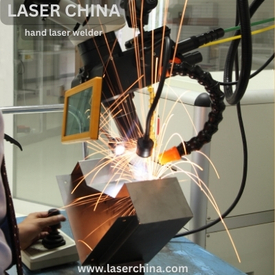- FREE Express Shipping On Orders $99+

Precision in the Palm of Your Hand: A Guide to Hand Laser Welders
In the dynamic world of metal fabrication, the emergence of hand laser welder has ushered in a new era of unparalleled precision and flexibility. These compact, portable systems have revolutionized the way welding is performed, empowering users to tackle a diverse range of applications with unprecedented control and agility. In this comprehensive guide, we will delve into the key features, operational principles, and practical applications of hand laser welder, equipping you with the knowledge to harness the power of this transformative technology.
At the heart of a hand laser welder lies a high-energy, compact laser source that generates a focused, coherent beam of light. Unlike their larger, stationary counterparts, these portable systems are designed to be easily maneuvered and positioned, allowing welders to access hard-to-reach areas and perform intricate, localized welding tasks with pinpoint accuracy.
One of the standout features of hand laser welder is their exceptional precision and control. The laser beam’s unique properties, combined with advanced beam delivery and manipulation systems, enable users to create highly consistent, high-quality welds with minimal heat input and distortion. This level of precision is particularly valuable in industries such as aerospace, automotive, and electronics, where even the slightest deviation can have significant consequences.
The versatility of hand laser welder is another key advantage. These systems are capable of processing a wide range of metal alloys, including stainless steel, aluminum, titanium, and various ferrous and non-ferrous materials, making them suitable for a diverse array of fabrication tasks. Additionally, the ability to precisely control the laser parameters, such as power, pulse duration, and beam profile, allows users to optimize the welding process for specific applications and material requirements.
Efficiency and productivity are hallmarks of hand laser welders. These compact, portable systems offer unparalleled processing speeds, enabling welders to complete tasks in a fraction of the time required by traditional welding methods. This increased efficiency translates into higher throughput, reduced manufacturing costs, and the ability to tackle even the most demanding production schedules. Furthermore, the non-contact nature of laser welding reduces the risk of mechanical distortion, further enhancing the overall quality and consistency of the final product.
Safety is a paramount concern when working with high-powered laser equipment, and hand laser welders are no exception. These systems incorporate robust safety features, including interlocked access panels, remote emergency stops, and advanced monitoring systems that continuously assess the welding environment. Additionally, the use of specialized personal protective equipment (PPE), such as laser-rated goggles and protective clothing, is essential for ensuring a safe working environment.
The integration of hand laser welders with automation and control systems further enhances their capabilities. Seamless integration with robotic arms, CNC controllers, and advanced software platforms enables the creation of highly repeatable, programmed welding sequences, making these systems ideal for a wide range of applications, from precision repair and maintenance to specialized fabrication tasks.
In conclusion, the transformative power of hand laser welder has revolutionized the future of metal fabrication. By understanding the key features, operational principles, and practical applications outlined in this guide, you’ll be equipped to harness the full potential of this cutting-edge technology and unlock new levels of precision, efficiency, and versatility in your metal fabrication processes.
